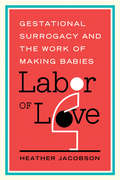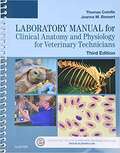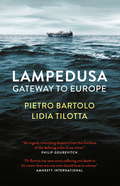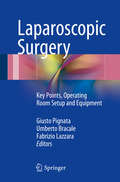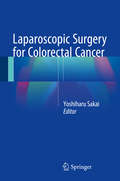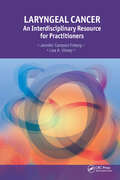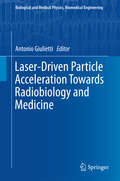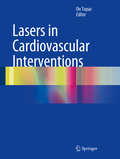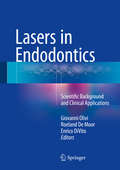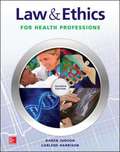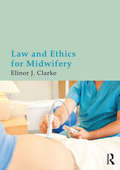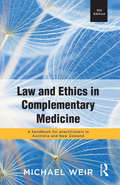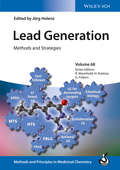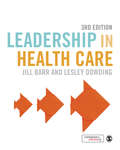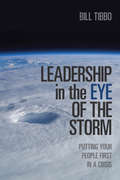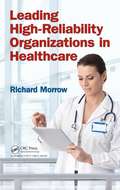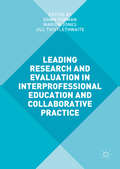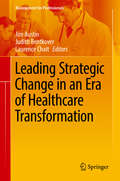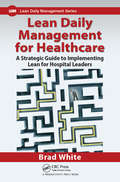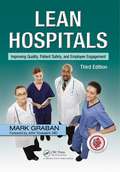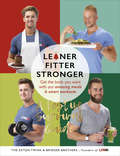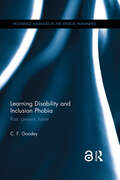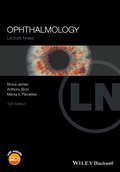- Table View
- List View
Labor of Love: Gestational Surrogacy and the Work of Making Babies
by Heather JacobsonWhile the practice of surrogacy has existed for millennia, new fertility technologies have allowed women to act as gestational surrogates, carrying children that are not genetically their own. While some women volunteer to act as gestational surrogates for friends or family members, others get paid for performing this service. The first ethnographic study of gestational surrogacy in the United States, Labor of Love examines the conflicted attitudes that emerge when the ostensibly priceless act of bringing a child into the world becomes a paid occupation. Heather Jacobson interviews not only surrogate mothers, but also their family members, the intended parents who employ surrogates, and the various professionals who work to facilitate the process. Seeking to understand how gestational surrogates perceive their vocation, she discovers that many regard surrogacy as a calling, but are reluctant to describe it as a job. In the process, Jacobson dissects the complex set of social attitudes underlying this resistance toward conceiving of pregnancy as a form of employment. Through her extensive field research, Jacobson gives readers a firsthand look at the many challenges faced by gestational surrogates, who deal with complicated medical procedures, delicate work-family balances, and tricky social dynamics. Yet Labor of Love also demonstrates the extent to which advances in reproductive technology are affecting all Americans, changing how we think about maternity, family, and the labor involved in giving birth. For more, visit http://www.heatherjacobsononline.com/
Laboratory Manual for Clinical Anatomy and Physiology for Veterinary Technicians
by Joanna M. Bassert Thomas ColvilleLearn to apply your A&P learning in the lab setting with Colville and Bassert’s Lab Manual for Clinical Anatomy and Physiology for Veterinary Technicians, 3rd Edition. This practical laboratory resource features a variety of activities, such as crossword puzzles, , terminology exercises, illustration identification and labeling, case presentations, and more to help reinforce your understanding of veterinary anatomy and physiology. The lab manual also features vivid illustrations, lists of terms and structures to be identified, and step-by-step dissection guides to walk you through the dissection process. <P><P> Clinically-oriented learning exercises help readers become familiar with the language of anatomy and physiology as you identify structures and learn concepts. Clear step-by-step dissection instructions for complex organs such as the heart familiarize readers with the dissection process in a very visual, easy-to-understand format. Learning objectives, the clinical significance of the content, and lists of terms and structures to be identified appear at the beginning of each chapter. Comprehensive glossary appears at the end of the lab manual and provides accurate, concise. High quality, full color illustrations provides a firm understanding of the details of anatomic structure. Review activities and study exercises are included in every chapter to reinforce important information. Clinical Application boxes are threaded throughout the lab manual and demonstrate the clinical relevance of anatomic and physiologic principles. Companion Evolve site includes answers to the Test Yourself questions in the textbook and crossword puzzles. NEW! Overview at a Glance sections outline the main proficiencies of each chapter and include a list of all exercises in the chapter.
Lampedusa: Gateway to Europe
by Lidia Tilotta Dr Pietro Bartolo"Bartolo tells us about rescuing everyone he can, burying those he cannot, and saving their stories as if they were his own. This is a personal, urgent and universal book" GLORIA STEINEM"An urgent, wrenching dispatch from the frontline of the defining crisis of our times . . . Bartolo is at once the saviour and the coroner to boatload after boatload of migrants who risk everything to cross the deadly seas. It is also a damning indictment of the broader, collective indifference of humankind to both the drowned and the saved" PHILIP GOUREVITCH"Dr Pietro Bartolo has seen more suffering and death in his career than any one man should have to witness" Amnesty International"Through Bartolo we understand that it is impossible to do nothing in the face of such great human need" Vanity FairIt is common to think of the refugee crisis as a recent phenomenon, but Dr Pietro Bartolo, who runs the clinic on the Italian island of Lampedusa, has been caring for its victims - both the living and the dead - for a quarter of a century.Situated some 200 km off Italy's Southern coast, Lampedusa has hit the world headlines in recent years as the first port of call for hundreds of thousands of African and Middle Eastern migrants hoping to make a new life in Europe.The shipwrecks began in 1992. Before the Arab Spring, they came from Africa, but now they come from across the Arab world as well. And the death toll is staggering. On Christmas Eve, 1996, 286 bodies were recovered; on the night of October 3, 2003, 366 out of 500 migrants died after a shipwreck nearby.For the past twenty-five years, Doctor Bartolo has been rescuing, welcoming, helping, and providing medical assistance to those who survived. But, above all, he has been listening to them. Tales of pain and hope, stories of those who didn't make it, who died at sea, their bodies washed up on shore; stories of those who lost their loved ones, of babies that never had a chance to be born.SHORTLISTED FOR THE ITALIAN PROSE TRANSLATION AWARD (IPTA)Translated from the Italian by Chenxin Jiang
Langzeitresultate in der Extremitäten- und Wirbelsäulenchirurgie
by Hans-Kaspar Schwyzer Beat René Simmen Rainer-Peter MeyerIn diesem Buch präsentieren 38 renommierte Orthopäden 38 beeindruckende Langzeitverläufe in der operativen Orthopädie und Unfallchirurgie:· Das Nicht-Kennen-Wollen unserer Langzeitresultate ist wie das Verdrängen unseres eigenen beruflichen Werdeganges.· Aus der Langzeitdokumentation holen wir unsere Sicherheit, dem medizinisch-industriellen Komplex mit all seinen kurzlebigen technischen Neuerungen gegenüber kritisch zu sein.· Das Erarbeiten von Langzeitresultaten manifestiert die hohe Eigenverantwortung, die wir unseren Patienten gegenüber haben.Ein Plädoyer für mehr Engagement bei Archivierung und Analyse von Langzeitverläufen!
Laparoscopic Surgery
by Giusto Pignata Umberto Bracale Fabrizio LazzaraThis book is distinctive in that it is a truly practical guide to use of the laparoscopic approach for the treatment of many abdominal diseases. Rather than simply offering a general description of surgical laparoscopic techniques, it provides the knowledge required in order to introduce basic laparoscopic procedures into daily practice or to commence advanced laparoscopic surgery. For each surgical procedure, key points are highlighted, the necessary equipment is described, and the operating room setup essential to avoid errors or loss of time is explained. Many flow charts, tables, and figures are included to assist fast and intuitive comprehension. The book will be of interest to all of the "actors" in the operating room, including especially surgeons in training, established surgeons, nurses, and anesthetists.
Laparoscopic Surgery for Colorectal Cancer
by Yoshiharu SakaiThis book provides simplified principles of surgical anatomy for colorectal cancers with sophisticated drawings, standard laparoscopic procedures with striking photographs and illustrations, and advanced procedures such as lateral pelvic node dissection and "down to top" or "reverse" total mesorectal excision. Oncological safety as well as minimum invasiveness of laparoscopic surgery for colorectal cancer has been acknowledged worldwide, based on long-term outcomes of several randomized controlled trials comparing laparoscopic surgery and open surgery. Developments in optical devices have provided us with a magnified clear vision of fine anatomical structures, facilitating our understanding of surgical anatomy and surgical procedures have been refined and improved accordingly. All these topics are presented in this book--valuable for surgical residents and experts eager to learn more about laparoscopic colorectal surgery--and readers will be enlightened by a new paradigm for "lap-enhanced surgical anatomy". Therefore this volume will greatly benefit not only colorectal surgeons but also general surgeons as well as gastroenterologists and oncologists.
Laryngeal Cancer: An Interdisciplinary Resource for Practitioners
by Jennifer Campion Friberg Lisa VinneyLaryngeal cancer is a complex medical condition, and its treatments, both surgical and nonsurgical, typically affect a variety of life functions. These complex consequences of laryngeal cancer necessitate that many different medical specialties work together as a cohesive, collaborative care team to support patients and their caregivers/families.Despite the interdisciplinary treatment that laryngeal cancer requires, many resources offer the perspective of only one specific profession. Laryngeal Cancer: An Interdisciplinary Resource for Practitioners caters to the team approach that is needed to provide patients with evidence-based treatment and maximize outcomes.To fill this need for an interdisciplinary text, Drs. Jennifer Campion Friberg and Lisa Vinney bring together a wide range of medical professionals to represent their unique perspectives on the treatment of patients with laryngeal cancer. Each chapter addresses a different critical aspect of the interdisciplinary care and how they impact the other aspects, written by experts in each field.Sample Chapters Include: Medical and Surgical Diagnosis Airway and Respiratory Challenges Nutrition and Swallowing Challenges Psychosocial Care of the Patient Bonus! A supplemental website is available for healthcare providers to share with their laryngeal cancer patients and their caregivers/families. This resource provides critical information about all aspects of their care and treatment, presented in a simple, digestible way for the layperson to understand.When the whole team of health care professionals involved in laryngeal cancer management understands the big picture of care, they can tailor individual treatment priorities to the needs of each unique patient and maximize quality of life. Because of this, Laryngeal Cancer: An Interdisciplinary Resource for Practitioners is designed to be a comprehensive guide for any professional involved in the many facets of interdisciplinary care for patients with laryngeal cancer.
Laser-Driven Particle Acceleration Towards Radiobiology and Medicine
by Antonio GiuliettiThis book deals with the new method of laser-driven acceleration for application to radiation biophysics and medicine. It provides multidisciplinary contributions from world leading scientist in order to assess the state of the art of innovative tools for radiation biology research and medical applications of ionizing radiation. The book contains insightful contributions on highly topical aspects of spatio-temporal radiation biophysics, evolving over several orders of magnitude, typically from femtosecond and sub-micrometer scales. Particular attention is devoted to the emerging technology of laser-driven particle accelerators and their application to spatio-temporal radiation biology and medical physics, customization of non-conventional and selective radiotherapy and optimized radioprotection protocols.
Lasers in Cardiovascular Interventions
by On TopazSince the introduction of laser devices to the medical sciences this technology has created great interest. Specifically, the laser's unique physical properties and precise bio-tissue interactions render this versatile source of biologic energy an attractive tool for multiple therapeutic purposes in cardiovascular medicine. Over the course of the last 2 decades the utilization of laser technology has become an important component for the management of patients with complex cardiovascular diseases. During this time period, cutting edge laser technology including a variety of wave length generators,newly designed catheters, and a selection of advanced optic fibershave been introduced and applied in the cardiovascular circulation. Improved lasing techniques in the cardiac catheterization suites and operation rooms have been implemented for treatment of ischemic coronary syndromes, peripheral arterial occlusive disease and other atherosclerotic thrombotic conditions. Moreover, during this 20 year time frame, several multicenter and single center clinical studies have been published focusing on the role and utilization of lasers in coronary and peripheral revascularization. And within the rapidly expanding field of interventional cardiac electrophysiology, laser technology has recently revolutionized the management of fractured, abandoned and malfunctioning leads of cardiac pacemakers and automatic defibrillators. Consequently, replacing a notoriously cumbersome and high risk open heart surgery with safe and markedly efficient percutaneous laser based extraction. This textbook will provide the most authoritative, comprehensive andcontemporary information covering technological progress, clinical experience and pertinent aspects of laser applications in cardiovascular medicine. It will be of interest to cardiologists, vascularsurgeons and interventional radiologist as well as medical students, scientists, biomedical engineering students and graduates.
Lasers in Endodontics
by Giovanni Olivi Roeland De Moor Enrico DivitoThis book offers up-to-date information on all aspects of the use of lasers in endodontics, focusing especially on the various laser applications, including primary and permanent root canal therapies, retreatments, apical surgery and pulp therapy. Every laser technique used in endodontics is carefully described and illustrated, with detailed coverage of both conventional methods and more recent developments such as laser-activated irrigation and photon-induced photoacoustic streaming. In addition, a separate section addresses the basic science of laser dentistry, explaining the physics, describing laser-tissue interactions, and discussing different types of laser. Extensive reference is made to the international literature in order to provide the reader with a clear, evidence-based understanding of the merits of various approaches. In offering a balanced mix of descriptions of clinical applications, clinical data, scientific research and logical criticism, the book will serve as an excellent reference for a wide audience comprising general dentists as well as specialists.
Law And Ethics: For The Health Professions (7th Edition)
by Karen Judson Carlene HarrisonLaw and Ethics for the Health Care Professions illustrates the numerous legal and ethical issues that health care professionals face every day. The topics are derived from real-life experiences and dilemmas from a variety of health care practitioners. Through the use of Learning Outcomes, Key Terms, Ethics Issues, Chapter Reviews, Case Studies, Internet Activities, Court Cases, and Video Vignettes, students hear from health care practitioners in various locations throughout the United States as they encounter legal and ethical problems and situations. Students will practice critical thinking skills to decide how to resolve the real-life situations or theoretical scenarios, determine why the court made a particular ruling and decide how the issues are relevant to the health care profession they will practice.
Law and Ethics for Midwifery
by Elinor ClarkeLegal and ethical competence is a cornerstone of professional midwifery practice and an essential part of midwifery training. Law and Ethics for Midwifery is a unique and practical resource for student midwives. Written by an experienced midwifery lecturer, this text draws on a wide variety of real life case studies and focuses particularly on the core areas of accountability, autonomy and advocacy. Opening with two chapters providing overviews respectively of ethical theories and legislation, the book is then arranged thematically. These chapters have a common structure which includes case studies, relevant legislation, reflective activities and a summary, and they run across areas of concern from negligence through safeguarding to record-keeping. Grounded in midwifery practice, the text enables student midwives to consider and prepare for ethical and legal dilemmas they may face as midwives in clinical practice.
Law and Ethics in Complementary Medicine: A handbook for practitioners in Australia and New Zealand
by Michael Weir'A valuable resource for those in clinical practice and students undertaking primary and secondary qualifications in the complementary medicine and therapy disciplines.' Caroline Smith, Professor, Complementary Medicine Research, National Institute of Complementary Medicine, Western Sydney UniversityComprehensive, unique and reflective of the current Australian legislative framework and AHPRA regulations, Michael Weir's Law and Ethics in Complementary Medicine remains the most widely used reference text in the field. A valuable handbook for professionals, students and researchers, the text addresses legal and ethical issues across a broad range of traditional, complementary and integrative practices.The text deals with legal and ethical issues in clinical relationships and provides practical guidelines for setting up and running a professional practice. Michael Weir systematically outlines the various aspects of the law which impact on clinical practice, including legal obligations to clients, consumer legislation and complaints processes, and professional boundaries. He explains how to navigate professional indemnity insurance, and the steps you need to take in setting up a professional practice from establishing a business name to dealing with employees. He also outlines the role of codes of ethics, and explores how to deal with tricky ethical issues in daily practice.This fifth edition is fully updated with in-depth treatment of the issue of ethical practice and professional decision making. It addresses recent changes in regulation and case law, including the development of the National Code of Conduct for Healthcare Workers and also now includes yoga and holistic counselling as modalities of complementary medicine.
Law, Immunization and the Right to Die
by Jennifer HardesLaw, Immunization and the Right to Die focuses on the urgent matter of legal appeals and judicial decisions on assisted death. Drawing on key cases from the United Kingdom and Canada, the book focuses on the problematic paternalism of legal decisions that currently deny assisted dying and questions why the law fails to recognize what many describe as "compassionate motives" for assisted death. When cases are analyzed as discourses that are part of a larger socio-political logic of governance, judicial decisions, it is argued here, reveal themselves as relying on the construction of neoliberal fictions – fictions that are here elucidated with reference to Michel Foucault’s theoretical insights on pastoral power and Roberto Esposito’s philosophical thesis on immunization. Challenging the socio-political logic of neoliberalism, the issue of assisted dying goes beyond the predominant legal concern with protecting – or immunizing – individuals from one another, in favor of minimal interference. This book calls for a new kind of politics: one that might affirm people and their finitude both more collectively, and more compassionately.
Lead Generation: Methods and Strategies, Volume 67
by Raimund Mannhold Gerd Folkers Hugo Kubinyi Jörg HolenzIn this comprehensive two-volume resource on the topic senior lead generation medicinal chemists present a coherent view of the current methods and strategies in industrial and academic lead generation. This is the first book to combine both standard and innovative approaches in comparable breadth and depth, including several recent successful lead generation case studies published here for the first time. Beginning with a general discussion of the underlying principles and strategies, individual lead generation approaches are described in detail, highlighting their strengths and weaknesses, along with all relevant bordering disciplines like e. g. target identification and validation, predictive methods, molecular recognition or lead quality matrices. Novel lead generation approaches for challenging targets like DNA-encoded library screening or chemical biology approaches are treated here side by side with established methods as high throughput and affinity screening, knowledge- or fragment-based lead generation, and collaborative approaches. Within the entire book, a very strong focus is given to highlight the application of the presented methods, so that the reader will be able to learn from `real life? examples. The final part of the book presents several lead generation case studies taken from different therapeutic fields, including diabetes, cardiovascular and respiratory diseases, neuroscience, infection and tropical diseases. The result is a prime knowledge resource for medicinal chemists and for every scientist involved in lead generation.
Leadership in Health Care
by Jill Barr Miss Lesley DowdingThis bestselling textbook helps students understand how important leadership skills are, at whatever level they are working at, as well as how to develop into a leader themselves. It supports students in getting to grips with essential theories and thinking critically about how these can be used to improve practice for quality patient care. The new edition covers the whole spectrum of topics relevant to leadership and management, including areas that people commonly struggle with such as conflict and delegation. Key features: · A website with videos of the authors explaining difficult concepts, exercises to help students apply theory to practice and weblinks to further resources · Case scenarios which demonstrate leadership in action across a variety of settings . Up-to-date, including the implications of the Francis report
Leadership in the Eye of the Storm: Putting Your People First in a Crisis
by Bill TibboCorporations need great leaders - particularly during times of distress and crisis. Shareholders, employees, and longtime customers all experience firsthand the disastrous effects poor leadership can have on the human side of the business equation.Leadership in the Eye of the Storm is a practical and inspirational guide that helps professionals create opportunity out of chaos. The book's insights are gleaned from the real life experiences of four North American profiled leaders who successfully navigated through the epicenter of their own storms by focusing first on the needs of their employees and families, and then the needs of their organizations. Events discussed include the 9/11 attacks, Hurricane Katrina, and the SARS outbreak. Tibbo offers a framework emerging from these narratives that enable future leaders to identify and cultivate the skills and behaviours required to not only meet the challenges but seize the opportunities that arise in times of chaos.
Leading High-Reliability Organizations in Healthcare
by Richard MorrowThis book details the attributes and practices that help high-reliability organizations (HROs) excel in the service they provide to their customers. Explaining what it takes to achieve high reliability in healthcare settings, it presents proven tools and concepts that leading healthcare organizations are using to improve safety and quality. The book identifies the necessary infrastructure, methods, and analytics required to achieve and sustain higher reliability. It also includes case studies that illustrate success stories and failures, so readers can avoid making the same mistakes.
Leading Research and Evaluation in Interprofessional Education and Collaborative Practice
by Marion Jones Jill Thistlethwaite Dawn FormanExpanding upon LeadershipDevelopment for Interprofessional Education and Collaborative Practice and Leadership and Collaboration, the thirdinstallment to this original and innovative collection of books considers avariety of research models and theories. Emphasizing research and evaluation inleadership aspects, Leading Research andEvaluation in Interprofessional Education and Collaborative Practice showcasesexamples from around the globe in various multicultural contexts. Crucial foracademics and researchers in this field, the book includes studies ontraditionally under-represented countries and aims to prompt new ideas forfuture research and policy structures in Interprofessional education andpractice.
Leading Strategic Change in an Era of Healthcare Transformation
by Jim Austin Judith Bentkover Laurence ChaitThis book focuses on how to lead transformative and strategic change in the healthcare industry in times of great uncertainty. Written for senior healthcare leaders, it will provide new tools, processes, examples and case studies offering an effective framework in which to transform healthcare systems. Specifically, leaders will be able to answer the following questions: * Why change? What has led us to today, and what is the current situation in healthcare? * What to change? What areas for change are most promising--areas with the greatest potential to yield significant benefits? * How to change? Will incremental changes meet the need, or are true transformations required? * When to change? Should changes start now, or should change wait for the stars to come into some special alignment? Healthcare is personal. Healthcare is local. And at the same time, healthcare is one of the greatest challenges faced by countries around the world. All major economies confront similar issues: "demand-side" growth in the care of aging populations in the face of "supply-side" resource constraints driven by ever-increasing costs of providing such care. While cultural, historical, and political differences among nations will yield different solutions, healthcare leaders across the globe must deal with ever-increasing uncertainty as to the scope and speed of their healthcare systems' evolution. The magnitude of these challenges calls for fundamental change to address inherent problems in the healthcare system and ensure sustainable access to healthcare for generations to come. The problem is understanding where and how to change. Failures of strategy are often failures to anticipate a reality different than what organizations are prepared or willing to see. Both system-wide and organizational transformation means doing current activities more efficiently while layering on change. This book aims to provide leaders with the tools to help organizations and health care systems adapt and evolve to meet the new challenges of healthcare as it continues to evolve. Praise for Leading Strategic Change in an Era of Healthcare Transformation "The authors make the case for healthcare transformation, and more importantly outline the required steps from changing mindsets to opinions development. . . a useful guide for all future healthcare leaders. " - John A. Quelch, Charles Edward Wilson Professor of Business Administration at Harvard Business School "There are several lifetimes of knowledge in the book about leading strategic transformation in the healthcare sector. . . Strategic transformation requires 2 ingredients: expertise in the healthcare sector and knowledge about leading change. This volume accomplishes both. " - Karen Hein, Former President of the William T. Grant Foundation, Adjunct Professor of Family & Community Medicine, Dartmouth Medical School and Visiting Fellow, Feinstein International Center, Tufts University "An essential guide for healthcare leaders seeking to transform their organization in these demanding times. " - Dr. Mario Moussa, President, Moussa Consulting and co-author of The Art of Woo: Using Strategic Persuasion to Sell Your Ideas and Committed Teams: Three Steps to Inspiring Passion and Performance
Lean Daily Management for Healthcare: A Strategic Guide to Implementing Lean for Hospital Leaders
by Brad WhiteYou likely don’t need any more tools, programs, or workshops to improve your hospital. What you need is a simple and consistent approach to manage problem-solving. Filling this need, this book presents a Lean management system that can help break down barriers between staff, directors, and administration and empower front-line staff to resolve their own problems.Lean Daily Management for Healthcare: A Strategic Guide to Implementing Lean for Hospital Leaders provides practical, step-by-step guidance on how to roll out Lean daily management in a hospital setting. Ideal for leaders that may feel lost in the transition process, the book supplies a roadmap to help you identify where your hospital currently is in its Lean process, where it’s headed, and how your role will change as you evolve into a Lean leader.Illustrating the entire process of implementing Lean daily management, the book breaks down the cultural progression of units into discreet, objectively measurable phases. It identifies what leaders at all levels of the organization must do to progress units into the next phase of development.Complete with case studies from different service areas in the hospital, the book explains how to link problem-solving boards together to achieve meaningful and measurable improvements in: the emergency department, the operating room, discharge times, clinics, quality, and patient satisfaction.After reading this book you will understand how consistent rounding, a few whiteboards, pen-and-paper data, and a focused effort on working the Plan-Do-Study-Act cycle can help you build a common problem-solving bench strength throughout your organization—establishing the framework upon which future improvement can be built.
Lean Hospitals: Improving Quality, Patient Safety, and Employee Engagement, Third Edition
by Mark GrabanOrganizations around the world are using Lean to redesign care and improve processes in a way that achieves and sustains meaningful results for patients, staff, physicians, and health systems. Lean Hospitals, Third Edition explains how to use the Lean methodology and mindsets to improve safety, quality, access, and morale while reducing costs, increasing capacity, and strengthening the long-term bottom line.This updated edition of a Shingo Research Award recipient begins with an overview of Lean methods. It explains how Lean practices can help reduce various frustrations for caregivers, prevent delays and harm for patients, and improve the long-term health of your organization.The second edition of this book presented new material on identifying waste, A3 problem solving, engaging employees in continuous improvement, and strategy deployment. This third edition adds new sections on structured Lean problem solving methods (including Toyota Kata), Lean Design, and other topics. Additional examples, case studies, and explanations are also included throughout the book.Mark Graban is also the co-author, with Joe Swartz, of the book Healthcare Kaizen: Engaging Frontline Staff in Sustainable Continuous Improvements, which is also a Shingo Research Award recipient. Mark and Joe also wrote The Executive’s Guide to Healthcare Kaizen.
Leaner, Fitter, Stronger: A Festive Survival Guide
by Tom Exton, James Exton, Max Bridger, Lloyd BridgerLearning Disability and Inclusion Phobia: Past, Present, Future (Routledge Advances in the Medical Humanities)
by C. F. GoodeyThe social position of learning disabled people has shifted rapidly over the last 20 years, from long-stay institutions, first into community homes and day centres, and now to a currently emerging goal of "ordinary lives" for individuals using person-centred support and personal budgets. These approaches promise to replace a century and a half of "scientific" pathological models based on expert assessment, and of the accompanying segregated social administration which determined how and where people led their lives, and who they were. This innovative volume explains how concepts of learning disability, intellectual disability and autism first came about, describes their more recent evolution in the formal disciplines of psychology, and shows the direct relevance of this historical knowledge to present and future policy, practice and research. Goodey argues that learning disability is not a historically stable category and different people are considered "learning disabled" as it changes over time. Using psychological and anthropological theory, he identifies the deeper lying pathology as "inclusion phobia", in which the tendency of human societies to establish an in-group and to assign out-groups reaches an extreme point. Thus the disability we call "intellectual" is a concept essential only to an era in which to be human is essentially to be deemed intelligent, autonomous and capable of rational choice. Interweaving the author's historical scholarship with his practice-based experience in the field, Learning Disability and Inclusion Phobia challenges myths about the past as well as about present-day concepts, exposing both the historical continuities and the radical discontinuities in thinking about learning disability.
Lecture Notes Ophthalmology
by Bruce James Bron ParulekarHighly illustrated, comprehensive, and accessible, Ophthalmology Lecture Notes is the ideal reference and revision guide to common eye problems and their diagnosis and management. Beginning with overviews of anatomy, history taking, and examination, it then covers a range of core ophthalmic conditions, including a new chapter on paediatric ophthalmology. The content has been thoroughly updated and includes: Over 200 diagrams and photographs A range of core clinical cases in chapter 20 demonstrating the clinical context of key conditions Learning objectives and summary of key points in each chapter Ophthalmology Lecture Notes is perfect for developing knowledge for clinical practice or revision in the run-up to examinations, and uses a systematic approach to provide medical students and junior doctors with all the tools they need to manage clinical situations. It is also useful for optometrists in training, helping them develop a sound understanding of clinical ophthalmology.
